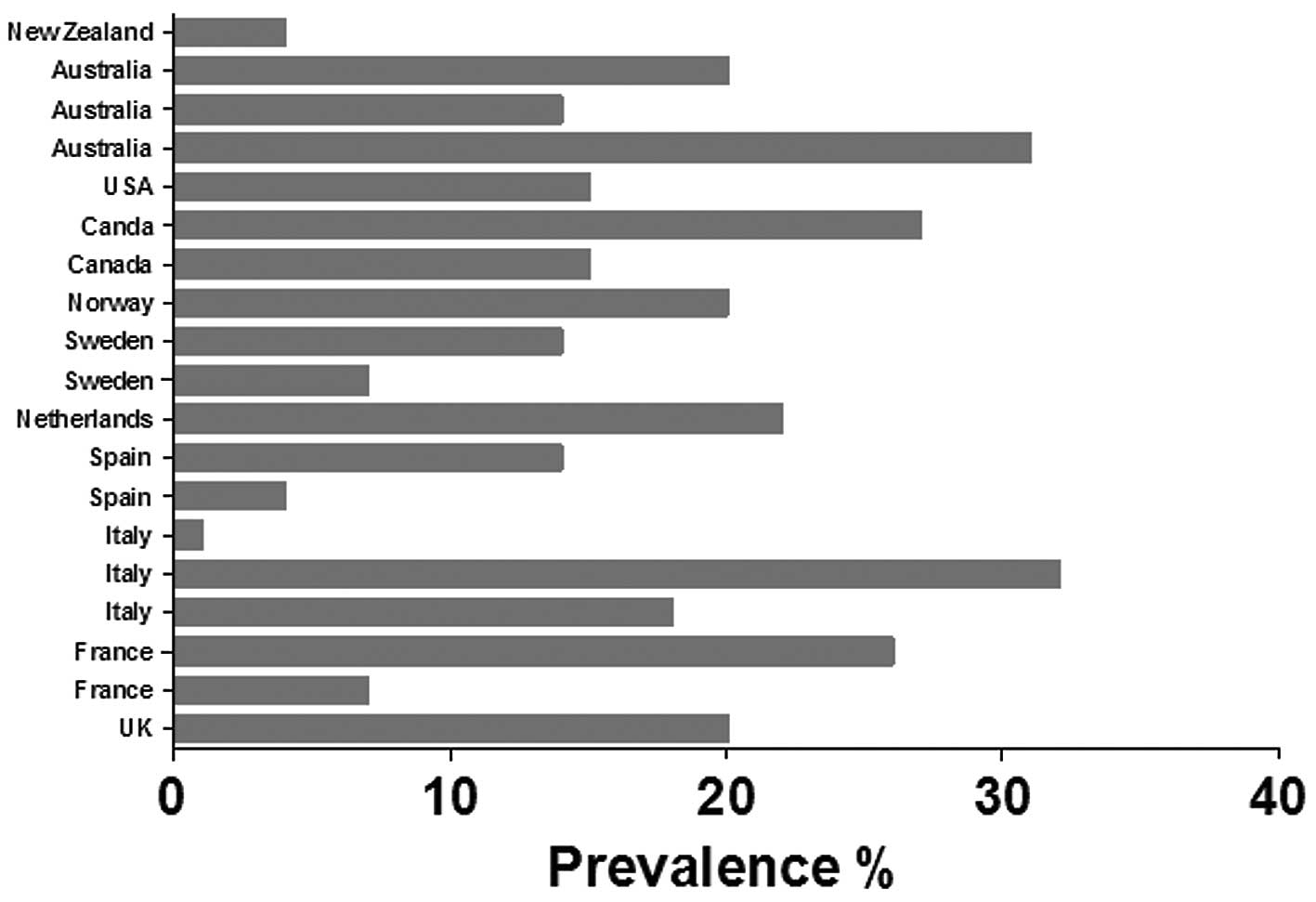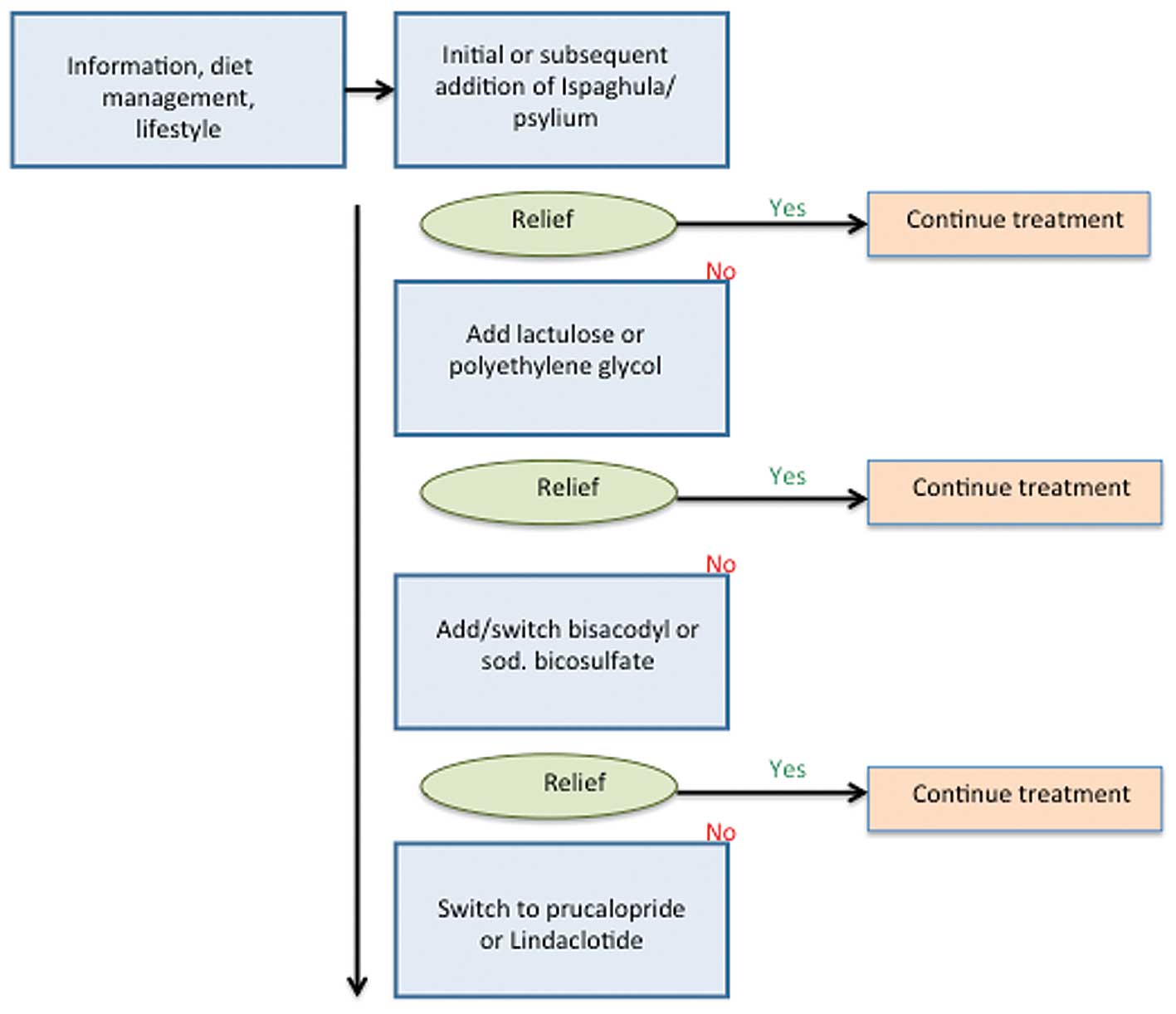|
1
|
Woodward S: Assessment and management of
constipation in older people. Nurs Older People. 24:21–26. 2012.
View Article : Google Scholar : PubMed/NCBI
|
|
2
|
Pare P: The approach to diagnosis and
treatment of chronic constipation: suggestions for a general
practitioner. Can J Gastroenterol. 25(Suppl B): 36B–40B.
2011.PubMed/NCBI
|
|
3
|
Lacy BE, Levenick JM and Crowell M:
Chronic constipation: new diagnostic and treatment approaches.
Therap Adv Gastroenterol. 5:233–247. 2012. View Article : Google Scholar : PubMed/NCBI
|
|
4
|
Peppas G, Alexiou VG, Mourtzoukou E and
Falagas ME: Epidemiology of constipation in Europe and Oceania: a
systematic review. BMC Gastroenterol. 8:52008. View Article : Google Scholar : PubMed/NCBI
|
|
5
|
Sanchez MI and Bercik P: Epidemiology and
burden of chronic constipation. Can J Gastroenterol. 25(Suppl B):
11B–15B. 2011.PubMed/NCBI
|
|
6
|
Irvine EJ, Ferrazzi S, Pare P, Thompson WG
and Rance L: Health-related quality of life in functional GI
disorders: focus on constipation and resource utilization. Am J
Gastroenterol. 97:1986–1993. 2002.PubMed/NCBI
|
|
7
|
Sun SX, Dibonaventura M, Purayidathil FW,
Wagner JS, Dabbous O and Mody R: Impact of chronic constipation on
health-related quality of life, work productivity, and healthcare
resource use: an analysis of the National Health and Wellness
Survey. Dig Dis Sci. 56:2688–2695. 2011.PubMed/NCBI
|
|
8
|
Everhart JE and Ruhl CE: Burden of
digestive diseases in the United States part II: lower
gastrointestinal diseases. Gastroenterology. 136:741–754. 2009.
View Article : Google Scholar : PubMed/NCBI
|
|
9
|
Sandler RS, Everhart JE, Donowitz M, et
al: The burden of selected digestive diseases in the United States.
Gastroenterology. 122:1500–1511. 2002. View Article : Google Scholar : PubMed/NCBI
|
|
10
|
Cheng C, Chan AO, Hui WM and Lam SK:
Coping strategies, illness perception, anxiety and depression of
patients with idiopathic constipation: a population-based study.
Aliment Pharmacol Ther. 18:319–326. 2003. View Article : Google Scholar : PubMed/NCBI
|
|
11
|
Mason HJ, Serrano-Ikkos E and Kamm MA:
Psychological state and quality of life in patients having
behavioral treatment (biofeedback) for intractable constipation. Am
J Gastroenterol. 97:3154–3159. 2002. View Article : Google Scholar : PubMed/NCBI
|
|
12
|
Haug TT, Mykletun A and Dahl AA: Are
anxiety and depression related to gastrointestinal symptoms in the
general population? Scand J Gastroenterol. 37:294–298. 2002.
View Article : Google Scholar : PubMed/NCBI
|
|
13
|
Martin BC, Barghout V and Cerulli A:
Direct medical costs of constipation in the United States. Managed
care interface. 19:43–49. 2006.PubMed/NCBI
|
|
14
|
Nyrop KA, Palsson OS, Levy RL, et al:
Costs of health care for irritable bowel syndrome, chronic
constipation, functional diarrhoea and functional abdominal pain.
Aliment Pharmacol Ther. 26:237–248. 2007. View Article : Google Scholar : PubMed/NCBI
|
|
15
|
Choung RS, Branda ME, Chitkara D, et al:
Longitudinal direct medical costs associated with constipation in
women. Aliment Pharmacol Ther. 33:251–260. 2011. View Article : Google Scholar : PubMed/NCBI
|
|
16
|
McCrea GL, Miaskowski C, Stotts NA, Macera
L and Varma MG: Pathophysiology of constipation in the older adult.
World J Gastroenterol. 14:2631–2638. 2008. View Article : Google Scholar : PubMed/NCBI
|
|
17
|
Sandström O and El-Salhy M: Ageing and
endocrine cells of human duodenum. Mech Ageing Dev. 108:39–48.
1999.
|
|
18
|
Sandström O and El-Salhy M: Human rectal
endocrine cells and aging. Mech Ageing Dev. 108:219–226.
1999.PubMed/NCBI
|
|
19
|
Quigley EM: Prucalopride: safety, efficacy
and potential applications. Therap Adv Gastroenterol. 5:23–30.
2012. View Article : Google Scholar : PubMed/NCBI
|
|
20
|
Krishnamurthy S, Schuffler MD, Rohrmann CA
and Pope CE II: Severe idiopathic constipation is associated with a
distinctive abnormality of the colonic myenteric plexus.
Gastroenterology. 88:26–34. 1985. View Article : Google Scholar : PubMed/NCBI
|
|
21
|
Schouten WR, ten Kate FJ, de Graaf EJ,
Gilberts EC, Simons JL and Klück P: Visceral neuropathy in slow
transit constipation: an immunohistochemical investigation with
monoclonal antibodies against neurofilament. Dis Colon Rectum.
36:1112–1117. 1993. View Article : Google Scholar
|
|
22
|
Wedel T, Roblick UJ, Ott V, et al:
Oligoneuronal hypoganglionosis in patients with idiopathic
slow-transit constipation. Dis Colon Rectum. 45:54–62. 2002.
View Article : Google Scholar : PubMed/NCBI
|
|
23
|
Park HJ, Kamm MA, Abbasi AM and Talbot IC:
Immunohistochemical study of the colonic muscle and innervation in
idiopathic chronic constipation. Dis Colon Rectum. 38:509–513.
1995. View Article : Google Scholar : PubMed/NCBI
|
|
24
|
El-Salhy M and Norrgård O: Colonic
neuroendocrine peptide levels in patients with chronic idiopathic
slow transit constipation. Ups J Med Sci. 103:223–230. 1998.
View Article : Google Scholar : PubMed/NCBI
|
|
25
|
Sjölund K, Ekman R, Akre F and Lindner P:
Motilin in chronic idiopathic constipation. Scand J Gastroenterol.
21:914–918. 1986.
|
|
26
|
Sjölund K, Fasth S, Ekman R, et al:
Neuropeptides in idiopathic chronic constipation (slow transit
constipation). Neurogastroenterol Motil. 9:143–150. 1997.PubMed/NCBI
|
|
27
|
Preston DM, Adrian TE, Christofides ND,
Lennard-Jones JE and Bloom SR: Positive correlation between
symptoms and circulating motilin, pancreatic polypeptide and
gastrin concentrations in functional bowel disorders. Gut.
26:1059–1064. 1985. View Article : Google Scholar
|
|
28
|
Tomita R, Fujisaki S, Ikeda T and Fukuzawa
M: Role of nitric oxide in the colon of patients with slow-transit
constipation. Dis Colon Rectum. 45:593–600. 2002. View Article : Google Scholar : PubMed/NCBI
|
|
29
|
Tomita R, Tanjoh K, Fujisaki S, Ikeda T
and Fukuzawa M: Regulation of the enteric nervous system in the
colon of patients with slow transit constipation.
Hepatogastroenterol. 49:1540–1544. 2002.
|
|
30
|
El-Salhy M, Norrgård O and Spinnell S:
Abnormal colonic endocrine cells in patients with chronic
idiopathic slow-transit constipation. Scand J Gastroenterol.
34:1007–1011. 1999. View Article : Google Scholar : PubMed/NCBI
|
|
31
|
El-Salhy M, Ostgaard H, Gundersen D,
Hatlebakk JG and Hausken T: The role of diet in the pathogenesis
and management of irritable bowel syndrome (Review). Int J Mol Med.
29:723–731. 2012.PubMed/NCBI
|
|
32
|
El-Salhy M, Seim I, Chopin L, Gundersen D,
Hatlebakk JG and Hausken T: Irritable bowel syndrome: the role of
gut neuroendocrine peptides. Front Biosci (Elite Ed). 4:2783–2800.
2012. View Article : Google Scholar : PubMed/NCBI
|
|
33
|
El-Salhy M, Gundersen D, Ostgaard H,
Lomholt-Beck B, Hatlebakk JG and Hausken T: Low densities of
serotonin and peptide YY cells in the colon of patients with
irritable bowel syndrome. Dig Dis Sci. 57:873–878. 2012. View Article : Google Scholar : PubMed/NCBI
|
|
34
|
El-Salhy M, Gundersen D, Hatlebakk JG and
Hausken T: Irritable Bowel Syndrome: Diagnosis, Pathogenesis and
Treatment Options. 1st edition. Nova Science Publishers, Inc; New
York: 2012
|
|
35
|
Tack J, Müller-Lissner S, Stanghellini V,
et al: Diagnosis and treatment of chronic constipation - a European
perspective. Neurogastroenterol Motil. 23:697–710. 2011. View Article : Google Scholar
|
|
36
|
Ostgaard H, Hausken T, Gundersen D and
El-Salhy M: Diet and effects of diet management on quality of life
and symptoms in patients with irritable bowel syndrome. Mol Med
Rep. 5:1382–1390. 2012.PubMed/NCBI
|
|
37
|
Johannesson E, Simrén M, Strid H, Bajor A
and Sadik R: Physical activity improves symptoms in irritable bowel
syndrome: a randomized controlled trial. Am J Gastroenterol.
106:915–922. 2011. View Article : Google Scholar : PubMed/NCBI
|
|
38
|
Chey WD and Rai J: Exercise and IBS: no
pain, no gain. Gastroenterology. 141:1941–1943. 2011. View Article : Google Scholar : PubMed/NCBI
|
|
39
|
Strid H, Simrén M, Störsrud S, Stotzer PO
and Sadik R: Effect of heavy exercise on gastrointestinal transit
in endurance athletes. Scand J Gastroenterol. 46:673–677. 2011.
View Article : Google Scholar : PubMed/NCBI
|
|
40
|
Wang Y, Kondo T, Suzukamo Y, Oouchida Y
and Izumi S: Vagal nerve regulation is essential for the increase
in gastric motility in response to mild exercise. Tohoku J Exp Med.
222:155–163. 2010. View Article : Google Scholar : PubMed/NCBI
|
|
41
|
Whelan K: Probiotics and prebiotics in the
management of irritable bowel syndrome: a review of recent clinical
trials and systematic reviews. Curr Opin Clin Nutr Metab Care.
14:581–587. 2011. View Article : Google Scholar : PubMed/NCBI
|
|
42
|
Whorwell PJ: Do probiotics improve
symptoms in patients with irritable bowel syndrome? Therap Adv
Gastroenterol. 2:37–44. 2009. View Article : Google Scholar : PubMed/NCBI
|
|
43
|
Spiller R: Review article: probiotics and
prebiotics in irritable bowel syndrome. Aliment Pharmacol Ther.
28:385–396. 2008. View Article : Google Scholar : PubMed/NCBI
|
|
44
|
Aragon G, Graham DB, Borum M and Doman DB:
Probiotic therapy for irritable bowel syndrome. Gastroenterol
Hepatol (NY). 6:39–44. 2010.PubMed/NCBI
|
|
45
|
El-Salhy M, Lillebø E, Reinemo A, Salmelid
L and Hausken T: Effects of a health program comprising
reassurance, diet management, probiotics administration and regular
exercise on symptoms and quality of life in patients with irritable
bowel syndrome. Gastroenterology Insights. 2:21–26. 2010.
View Article : Google Scholar
|
|
46
|
Spiller RC: Upper gut dysmotility in
slow-transit constipation: is it evidence for a pan-enteric
neurological deficit in severe slow transit constipation? Eur J
Gastroenterol Hepatol. 11:693–696. 1999. View Article : Google Scholar : PubMed/NCBI
|
|
47
|
Quigley EM, Vandeplassche L, Kerstens R
and Ausma J: Clinical trial: the efficacy, impact on quality of
life, and safety and tolerability of prucalopride in severe chronic
constipation - a 12-week, randomized, double-blind,
placebo-controlled study. Aliment Pharmacol Ther. 29:315–328. 2009.
View Article : Google Scholar : PubMed/NCBI
|
|
48
|
Tack J, Camilleri M, Chang L, et al:
Systematic review: cardiovascular safety profile of 5-HT(4)
agonists developed for gastrointestinal disorders. Aliment
Pharmacol Ther. 35:745–767. 2012. View Article : Google Scholar : PubMed/NCBI
|
|
49
|
Ke M, Zou D, Yuan Y, et al: Prucalopride
in the treatment of chronic constipation in patients from the
Asia-Pacific region: a randomized, double-blind, placebo-controlled
study. Neurogastroenterol Motil. 24:999–e541. 2012. View Article : Google Scholar : PubMed/NCBI
|
|
50
|
Camilleri M, Van Outryve MJ, Beyens G,
Kerstens R, Robinson P and Vandeplassche L: Clinical trial: the
efficacy of open-label prucalopride treatment in patients with
chronic constipation - follow-up of patients from the pivotal
studies. Aliment Pharmacol Ther. 32:1113–1123. 2010. View Article : Google Scholar : PubMed/NCBI
|
|
51
|
Camilleri M, Beyens G, Kerstens R,
Robinson P and Vandeplassche L: Safety assessment of prucalopride
in elderly patients with constipation: a double-blind,
placebo-controlled study. Neurogastroenterol Motil. 21:1256–e1117.
2009. View Article : Google Scholar : PubMed/NCBI
|
|
52
|
Johnston JM, Shiff SJ and Quigley EM: A
review of the clinical efficacy of linaclotide in irritable bowel
syndrome with constipation. Curr Med Res Opin. 29:149–160. 2013.
View Article : Google Scholar : PubMed/NCBI
|
|
53
|
Emmanuel A: Current management strategies
and therapeutic targets in chronic constipation. Therap Adv
Gastroenterol. 4:37–48. 2011. View Article : Google Scholar : PubMed/NCBI
|


















